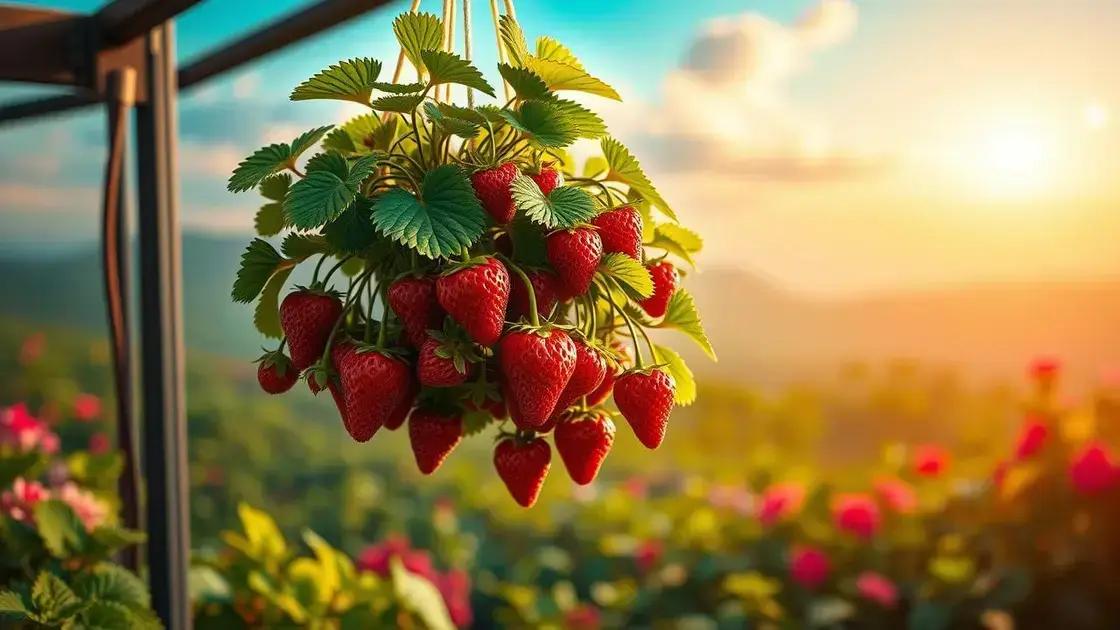How to Take Care of a Hanging Strawberry Plant: 7 Essential Tips
How to take care of a hanging strawberry plant can seem daunting, yet it offers delicious rewards. Imagine plucking fresh, juicy strawberries right from your own backyard. With simple yet effective methods, you can cultivate thriving strawberry plants that produce sweet fruit throughout the season. Discover the essentials below for maintaining your hanging strawberry plants effectively.
Table of Contents
ToggleChoosing the right hanging planter for strawberries
Choosing the right hanging planter for strawberries is crucial for their growth and productivity. The right container will provide the necessary support and conditions for strawberries to thrive. Here are some factors to consider when selecting a hanging planter:
- Material: Opt for planters made of breathable materials, such as terracotta or fabric, which allow for proper drainage and air circulation.
- Size: Choose planters that are at least 12 inches deep and wide to allow sufficient space for the strawberry roots to grow.
- Design: Select a planter with drainage holes to prevent waterlogging and promote healthy root development.
When deciding on a hanging planter, consider the following benefits:
- Enhanced growth: A well-designed hanging planter can encourage healthier plants by avoiding overcrowding.
- Accessibility: Hanging planters make it easier to reach and harvest strawberries, reducing strain.
- Aesthetic appeal: They can beautify your space, adding a fresh look to your garden or porch.
Additionally, here are examples of popular hanging planters that work well for strawberries:
| Planter Type | Material | Size | Features |
|---|---|---|---|
| Fabric pots | Fabric | 12 inches | Good drainage, breathable |
| Wooden planters | Wood | 16 inches | Natural aesthetics, durable |
| Plastic hanging pots | Plastic | 14 inches | Lightweight, various colors |
For those interested in growing strawberries indoors, consider exploring indoor gardening techniques to determine the best approach for your environment.
Optimal sunlight and watering requirements

Optimal sunlight and watering requirements are crucial for the health of your hanging strawberry plants. These factors significantly influence fruit production and plant vitality. Here’s how to ensure your strawberries get the care they need.
Sunlight exposure for strawberry plants
Strawberries thrive best with adequate sunlight. Aim for:
- At least 6-8 hours of direct sunlight daily.
- A well-lit spot that receives morning sun, which helps dry the leaves quickly and reduces disease risk.
Understanding watering needs
Proper watering is essential for maintaining healthy strawberry plants. Follow these guidelines:
- Watering frequency: Water your hanging strawberry plants every 2-3 days, depending on weather conditions.
- Watering method: Use a soaker hose or drip irrigation to ensure moisture reaches the roots without wetting the foliage.
- Signs of over or under watering: Yellowing leaves indicate overwatering, while wilting or dry leaves suggest under-watering.
Additional tips for thriving strawberries
To enhance your strawberries’ environment, consider the following:
- Mulch around the base of your plants to retain moisture and regulate temperature.
- Adjust watering during fruiting season to keep the soil consistently moist for better berry development.
For those interested in growing strawberries indoors, consider exploring indoor gardening techniques to adapt your watering and sunlight strategy for an indoor environment.
Essential nutrients and pest management for strawberries
Essential nutrients and pest management for strawberries play a significant role in ensuring healthy plants and abundant fruit. Proper nutrition and pest control help maximize your hanging strawberry plant’s productivity and longevity.
Key nutrients for optimal growth
Strawberries require specific nutrients to thrive. Here are the essential ones to consider:
- Nitrogen: Crucial for leaf development and overall growth.
- Phosphorus: Supports strong root development and fruit quality.
- Potassium: Enhances fruit size and flavor while improving disease resistance.
Fertilization schedule
For effective nutrient management, follow this fertilization schedule:
- Pre-planting: Amend the soil with compost or well-rotted manure to establish a nutrient-rich base.
- Growing season: Apply a balanced fertilizer every 4-6 weeks during active growth.
- Post-harvest: Provide a low-nitrogen fertilizer to prepare plants for the next season.
Pest management strategies
Managing pests is vital to protect your strawberry plants. Implement these strategies:
- Regular inspection: Check for pests like aphids, spider mites, and slugs frequently.
- Companion planting: Planting flowers like marigold can deter pests naturally.
- Organic pesticides: Use neem oil or insecticidal soap to treat infestations safely.
For indoor strawberry cultivation, consider exploring indoor gardening techniques to adapt your nutrient and pest management strategies.
In conclusion
Caring for hanging strawberry plants involves understanding their unique needs for sunlight, water, nutrients, and pest management. By selecting the right hanging planters, ensuring optimal sunlight and watering practices, and providing essential nutrients along with effective pest control, you will be on your way to enjoying a bountiful harvest of delicious strawberries. For those interested in further enhancing their indoor gardening skills, check out these tips on enhancing your indoor garden.

